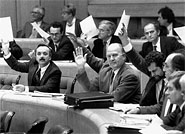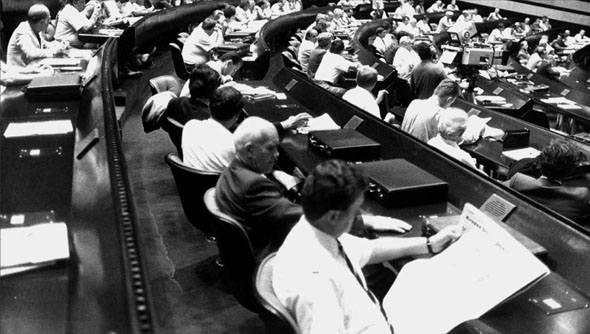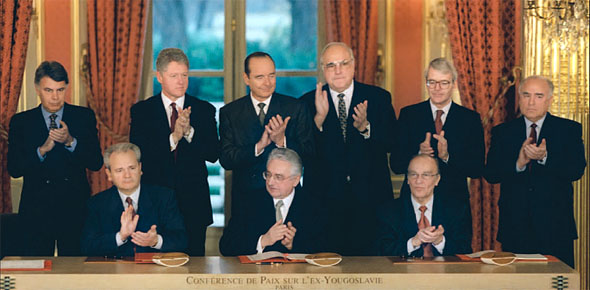History of Parliamentarism in BiH
Parliamentarism in Bosnia and Herzegovina in conditions of political pluralism (1990 – 1995)
Political pluralism in Bosnia and Herzegovina was closely connected with developments at an international level – the fall of communism and the internal crisis in Yugoslavia which escalated in political, economic, ethnic and social terms and in many others areas of life and work.
(Monographs of the "Parliamentary Assembly of Bosnia and Herzegovina, the 2010 edition.)

In the period between 1980, which was marked by the death of Josip Broz Tito, and 1989, when the League of Communists of Yugoslavia fell apart at last at the Fourteenth Congress, various political options, associations and movements appeared throughout all of the Yugoslav Republics. In Bosnia and Herzegovina, intensified pluralistic interests were publicly expressed after the Tenth Congress of the League of Communists of Bosnia and Herzegovina. Serious preparations by the new political parties were underway even at a time when the League of Communists of Bosnia and Herzegovina debated as to whether it should allowed for ethnicity-based parties to be established at all. However, the reality went beyond the system in power. On May 26, 1990, the Party of Democratic Action (orig. SDA) held its Constituent Assembly; the Serbian Democratic Party (orig. SDS) held its on July 12, 1990, and the Croatian Democratic Union (orig. HDZ) on August 18, 1990. Apart from these parties, left-oriented political parties also appeared: the League of Communists – Socialist Democratic Party, the Democratic Socialist Alliance of Bosnia and Herzegovina and the Alliance of Reform Forces. The constitutional requirements for the introduction of the multi-party political system in Bosnia and Herzegovina and for holding multi-party elections were satisfied once amendments LIX-LXXX to the Constitution of the Socialist Republic of Bosnia and Herzegovina were enacted in July 1990. Freedom of political organization and activity were guaranteed, while organizations and activities intended to violently overthrow the constitutional system were banned. It was also stipulated that, based on universal and equal suffrage and by voting directly or secretly, citizens would elect representatives to the assemblies of the social-political communities to a 4-year mandate.
In accordance with the abovementioned amendments, the Assembly of the Socialist Republic of Bosnia and Herzegovina was reorganized into two Councils: the Council of Citizens, to which 130 representatives were directly elected, and the Council of Municipalities, to which every municipality and urban community elected one representative each. The Assembly of the Socialist Republic of Bosnia and Herzegovina was authorized to elect and relieve of duty a member of the Presidency of SFRY from Bosnia and Herzegovina by secret voting at the proposal of the Presidency of the Socialist Republic of Bosnia and Herzegovina, whereby citizens were to previously and directly declare themselves thereof. However, that procedure was previously applied in Bosnia and Herzegovina in 1989, when Bogić Bogićević was elected to fill the vacant position of member of the Presidency of SFRY from the Socialist Republic of Bosnia and Herzegovina. It was regulated by an amendment that, by the citizens’ direct, universal and secret voting, the Presidency of the Socialist Republic of Bosnia and Herzegovina comprising seven members should be elected to four years, with the possibility of having one more successive mandate. With Constitutional Law on the Implementation of Amendments to the Constitution of the Socialist Republic of Bosnia and Herzegovina was stipulated that numerous laws should be enacted by September 15, 1990 concerning the following: the election of councilmen and representatives to the assembly of socialpolitical communities, the election and revocation of members of the Presidency of the Socialist Republic of Bosnia and Herzegovina, the election precincts for the election of representatives to the councils of the Assembly of the Socialist Republic of Bosnia and Herzegovina, voters’ lists, political organizations, public information and the Law on Radio-Television Sarajevo. All of these constitutional solutions and the accompanying regulations promoted ethnicity as the basis for political legitimacy.

A session of both Councils of the Assembly of the Socialist Republic of Bosnia and Herzegovina in June, 1991
The elections of November 18, 1990 were held based on the Decision of the President of the Assembly of the Socialist Republic of Bosnia and Herzegovina to elect both the members of the Presidency of the Socialist Republic of Bosnia and Herzegovina and the Assembly of the Socialist Republic of Bosnia and Herzegovina. When registering voters, passive registration at the municipality level was applied, based on the data citizens provided when reporting their permanent places of residence. The total number of citizens entered into the voters’ lists was 3,033,921, of whom 100,432 were temporarily employed abroad. For the elections to be legitimate, it was required that more than 50% of voters registered with the universal voters list vote.
There were four candidate lists (printed as parts of a giant ballot sheet) for the members of the Presidency of the Socialist Republic of Bosnia and Herzegovina, which included Muslim, Serb and Croat candidates, as well as others who did not declare themselves ethnically or who belonged to other ethnicities. Those who won a relative majority from every ethnic group were elected members of the Presidency of the Socialist Republic of Bosnia and Herzegovina. Alija Izetbegović became the President of the Presidency of the Socialist Republic of Bosnia and Herzegovina. The election of 240 representatives to the two Chambers of the Assembly of the Socialist Republic of Bosnia and Herzegovina must have reflected the representation of the constituent peoples in Bosnia and Herzegovina according to the 1981 census, given a +/- 15% deviation. Of the 43 registered parties, 15 participated in the elections independently or in coalitions. The Party for Democratic Action (SDA), the Serbian Democratic Party (SDS) and the Croatian Democratic Union (HDZ) won the elections by a vast majority, with 84% of representative seats in the Republic Parliament, 75.5% of representative seats in the municipal assemblies and 60.83% of the representative seats in the Assembly of the City of Sarajevo. Momčilo Krajišnik and Jure Pelivan were elected President of the Assembly of the Socialist Republic of Bosnia and Herzegovina and President of the Government, respectively.
Based on these election results a coalition of the three ethnicity-based political parties was created within the territory of Bosnia and Herzegovina. However, even by the first session, their deep differences in resolving the open issues were extremely clear. Their political interests were diametrically opposed, primarily with regard to the most important issues regarding the state government’s sovereignty.
After the 1990 elections, open differences continued to exist in the political representative bodies of Bosnia and Herzegovina. This was the period of dissolution of Yugoslavia and intensive negotiations between the six Presidents of the Republic Presidencies who could not find a way out of the deep Yugoslav crisis. The dissolution of Yugoslavia was also followed by the process of the establishment of parallel structures of authorities. Less than a year had passed after the first multi-party elections in Bosnia and Herzegovina when the combat raging in Croatia moved to Bosnia and Herzegovina. The first location in Bosnia and Herzegovina that already by September 1991 had experienced the horrors of war was the village of Ravno. At the same time, the Assembly of the Serb people of Bosnia and Herzegovina was formed in Pale near Sarajevo on October 24, 1991. On January 9, 1992, this Assembly adopted a Declaration on the Proclamation of the Srpska Republika of Bosnia and Herzegovina (its name was changed to the Republika Srpska on August 12). On November 18 1991, the Croatian Community Herzeg-Bosna was proclaimed in Grude.
In late 1991, apart from the internal political sphere, a decision on the fate of Yugoslavia at the international level was to be made. After the Conference on Yugoslavia on November 5, 1991 in the Hague, the Arbitration Committee publicly assessed that it was concerned with the dissolution, not secession of certain state members of SFRY, which meant that it had no longer had a legal identity.The European Community issued a Declaration on Yugoslavia on December 16, 1991, inviting all of the Yugoslav Republics to apply for the status of independent countries by December 23, 1991. Soon afterwards, on December 20, 1991, the Presidency of the Socialist Republic of Bosnia and Herzegovina rendered a decision to apply for the recognition of the Socialist Republic of Bosnia and Herzegovina as an independent country, but this decision was not supported by the Serb members of Presidency. However, based on the report of the Arbitration Committee of the Conference on Yugoslavia, international recognition of Bosnia and Herzegovina was conditional upon holding a general referendum under international supervision. Accordingly, at the joint session of both councils on January 25, 1992, the Assembly of the Socialist Republic of Bosnia and Herzegovina rendered a decision to hold a referendum on the sovereignty and independence of Bosnia and Herzegovina. This decision again was not supported by a large number of the Serb representatives, who left the Assembly of the Socialist Republic of Bosnia and Herzegovina on that very occasion.
The Referendum on independence was held between February 29 and March 1, 1992. Of a total number of 3,253,847 voters, 64.31% of citizens having the right to vote participated in and voted at the Republic referendum for the establishment of the status of Bosnia and Herzegovina, of which number 99.44% voted “for” the sovereignty of Bosnia and Herzegovina. The referendum results also secured the international recognition of Bosnia and Herzegovina as an independent country.
On April 6, 1992 the state members of the European Community recognized Bosnia and Herzegovina as an independent and sovereign country, while the United States of America did the same the following day. On May 22, 1992, Bosnia and Herzegovina was admitted into and became a member state of the United Nations.

Signing of Peace Accords in Paris on 14 December 1995
Presidency of the Socialist Republic of Bosnia and Herzegovina rendered a decision to apply for the recognition of the Socialist Republic of Bosnia and Herzegovina as an independent country, but this decision was not supported by the Serb members of Presidency. However, based on the report of the Arbitration Committee of the Conference on Yugoslavia, international recognition of Bosnia and Herzegovina was conditional upon holding a general referendum under international supervision. Accordingly, at the joint session of both councils on January 25, 1992, the Assembly of the Socialist Republic of Bosnia and Herzegovina rendered a decision to hold a referendum on the sovereignty and independence of Bosnia and Herzegovina. This decision again was not supported by a large number of the Serb representatives, who left the Assembly of the Socialist Republic of Bosnia and Herzegovina on that very occasion. The Referendum on independence was held between February 29 and March 1, 1992. Of a total number of 3,253,847 voters, 64.31% of citizens having the right to vote participated in and voted at the Republic referendum for the establishment of the status of Bosnia and Herzegovina, of which number 99.44% voted “for” the sovereignty of Bosnia and Herzegovina. The referendum results also secured the international recognition of Bosnia and Herzegovina as an independent country. On April 6, 1992 the state members of the European Community recognized Bosnia and Herzegovina as an independent and sovereign country, while the United States of America did the same the following day. On May 22, 1992, Bosnia and Herzegovina was admitted into and became a member state of the United Nations. on Supplements to the Constitution of the Republic of Bosnia and Herzegovina which provided for the constitutional basis for the internal reshaping of a part of the Republic of Bosnia and Herzegovina.
However, upon the completion of the Dayton (USA) peace negotiations on November 21, 1995 and the signing of the Peace Agreement in Paris on December 14, 1995 the war in Bosnia and Herzegovina stopped. The Agreement was signed finally and irrevocably by the Presidents of the three states: the Republic of Bosnia and Herzegovina, the Federal Republic of Yugoslavia (comprising the two currently independent states of Serbia and Montenegro) and the Republic of Croatia. That meant that no possibility was left for the recognition and ratification of the legislative authorities of the signatory countries. The General Framework Agreement for Peace includes 11 Annexes (Military Aspects of the Peace Settlement, Inter-Entity Boundary Line and Related Issues, Elections, the Constitution of Bosnia and Herzegovina, Arbitration, Human Rights, Refugees and Displaced Persons, Commission to Preserve National Monuments, Establishment of Bosnia and Herzegovina Public Corporations, the Civilian Implementation of Peace Settlement and the International Police Task Force). The Dayton Peace Agreement confirmed that Bosnia and Herzegovina is an independent and sovereign country which continues to exist legally within its current, internationally recognized borders, and with a modified internal structure comprising two entities: the Federation of Bosnia and Herzegovina and the Republika Srpska. With its new Constitution and system, Bosnia and Herzegovina entered into a period of overwhelming challenges in terms of social recovery, reconstruction and institution building.
– Dr Vera Katz

